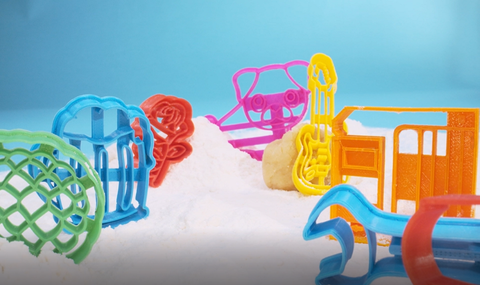
Make your own cookie cutters: The perfect guide for cookie lovers
Make your own cookie cutters: The perfect guide for cookie lovers
DIY instructions for making your own cookie cutters
Homemade cookie cutters are the key to custom baking projects! Imagine being able to design any cookie shape you can imagine - from hearts to stars to personalized designs. DIY cookie cutters are not only practical, but also a creative way to reuse old materials. Plus, it's incredibly fun to make your own cookie cutters and create something of your own.
So why should you make your own cookie cutters? The answer is simple: they are flexible, inexpensive and perfect for creating unique creations for special occasions.
In our guide we present you 3 ways how you can make your own cookie cutters at home. From simple aluminum cookie cutters to innovative 3D printed cookie cutters.
You don't have the time or desire to make your own cookie cutters? With our service for custom cookie cutters, you can easily get your desired image as a cookie cutter.

Preparation
Before you start, you should think about what shape you want your cookie cutters to be. Are you a fan of classic motifs like stars or hearts? Or would you prefer something more unique, such as your pet's name or a favorite symbol?
Here are a few tips:
- Draw the design: Sketch the desired shape on paper to get a first impression.
- Plan the size: Make sure the pan fits the size of the cookies.
- Gather inspiration: Use online platforms like Pinterest to find creative ideas.
The selection of the manufacturing process
Depending on the desired properties of the cookie cutters, you should choose the manufacturing method. For your project to be a success, you also need the right materials and tools, as well as knowledge of how to use the equipment. Here is a brief overview so that you can choose the right method:
1. Aluminum foil cookie cutter

Advantages: Simple manufacturing method, No sharp edges
Disadvantages: Only outer contour possible, no embossed elements, short durability
Materials:
- Aluminum foil or plastic filament
- Food-grade glue (if required)
Tools:
- Ruler and scissors
- Cardboard
2. Make metal cookie cutters

Advantages: Very long shelf life
Disadvantages: Strenuous manufacturing method, Only a few embossed elements possible, Sharp edges, Not suitable for children
Materials:
- Thin aluminum or stainless steel sheet
- Food-grade glue (if required)
Tools:
- Ruler and scissors
- Tongs
- File
- Optional: Welding machine
3. Cookie cutters from the 3D printer

Advantages: Long durability, No sharp edges, Detailed embossed elements, Suitable for children
Disadvantages: High acquisition costs for 3D printers, food-grade plastic and correct manufacturing required
Materials:
- Food-safe plastic filament
- 3D design (STL file) of the cookie cutter
Tools:
- Ruler and scissors
- 3D printer
- Lighter
The simple approach: make cookie cutters from aluminum foil
For quick projects, aluminum foil is a great option. The advantages are that the cutters are quick to make and easy to handle. The disadvantages are that they don't last long and the cutters are less detailed.
Here are the instructions:
- Cut a long piece of aluminum foil.
- Fold it several times until you get a stable strip.
- Form the strip into the desired shape and secure the ends together. Use food-safe glue if necessary.
The robust approach: making cookie cutters out of metal
Metal is robust and durable - perfect for cookie cutters! With a little muscle power and skill, you can easily make cookie cutters. The optimal procedure is as follows:
Step 1: Choosing the right metal
Choose a thin but sturdy metal like aluminum or stainless steel. Make sure it is food safe and easy to bend.
Step 2: Cutting the metal
Cut the metal into a long strip. The length should be enough to bend the desired shape.
Step 3: Shaping and Fixing
Carefully bend the metal strip along the pre-drawn design. Use pliers for precise edges and a file to smooth out any sharp spots. Secure the ends with food-safe glue or by welding.
The innovative approach: making cookie cutters out of plastic
If you have access to a 3D printer, new possibilities open up! The biggest hurdle is creating the 3D design. Once you have this as an STL file, you can print your cookie cutter directly at home. Here's how to proceed if you want to produce cookie cutters using 3D printing:
1. Create a 3D design : Use software like Tinkercad or Cookiecad to design your shape digitally or search for suitable shapes on online platforms like Printables .
2. 3D printing cookie cutters : Upload the design to your 3D printer and print it with food-safe filament. Make sure that the manufacturing is correct to ensure that the final product will come into contact with food.
3. Use a cookie cutter : Plastic cookie cutters are light, flexible and ideal for beginners. They also offer great embossing elements, which means you can get beautiful cookies even without icing and decoration.
If you don't have a 3D printer or can't produce your desired design, please contact us. We can create your unique cookie cutters based on just a picture.

Decorative cookie cutters
The special thing about homemade cookie cutters is the opportunity to be creative. Why settle for simple shapes when you can create original designs? Decorative cookie cutters can have the following shapes, for example:
- Thematic motifs: For Christmas, stars, bells or snowmen . For Easter , bunnies or eggs .
- Personalized designs: letters, numbers or even the outline of a face.
- Playful shapes: animals, flowers or fantasy symbols such as unicorns or dragons.
A tip: To find inspiration, you can browse online galleries or simply experiment with pencil on paper. You will be amazed at the creative ideas you come up with!
security aspects
When making cookie cutters, safety is paramount. Especially when working with metal, you should take some precautions:
- Avoid sharp edges: Use a file to round off the edges and prevent injuries.
- Food-safe materials: Make sure the materials used are safe for contact with food.
- Use tools correctly: Avoid improvised tools that could break or slip.
Another tip: When working with children, use soft materials such as plastic to prevent injuries.
durability and care
Homemade cookie cutters will last a long time if properly cared for. Here are a few tips to extend their lifespan:
- Cleaning: Rinse the cutters thoroughly with warm water and detergent after each use.
- Drying: Dry the cookie cutters carefully, especially if they are made of metal, to avoid rusting.
- Storage: Store the cookie cutters in a dry place, ideally in a box or bag.
For 3D printed plastic cookie cutters, simply wiping them down is often enough. Be careful not to put them in the dishwasher as high temperatures can warp them unless you have dishwasher safe cookie cutters .
Practical tips for use
Now that you've made your own cookie cutters, you'll want to get the most out of them. Here are a few handy tips for making the best cookie cutters :
- The right dough thickness: Roll out the dough evenly – 5-7 mm is ideal. This makes it easier to cut out the cookies.
- Non-stick tricks: Dip the cutters in flour or dust them lightly so that the dough does not stick.
- Clean cuts: Press the cutters straight down without wiggling them to get clean edges.
These little tricks make a big difference and ensure that your cookies look like they were made by a professional.
Advantages of the DIY method compared to purchased cookie cutters
Homemade cookie cutters have many advantages over the store-bought versions. Firstly, you can create truly unique designs that you can't buy anywhere else. Secondly, it is often cheaper and more environmentally friendly to recycle old materials.
Another advantage? You can adjust the size and shape to suit your needs. This is especially useful if you are baking cookies for special occasions such as birthdays or weddings.
If you don't have the time to throw yourself into a craft project, check out our unique cookie cutters.
sustainability and environmental friendliness
Making your own cookie cutters is not only creative but also a sustainable option. Here are some reasons why:
- Reuse materials: Old aluminum sheets, plastic packaging or even thick cardboard can be converted into useful cookie cutters.
- Avoid plastic waste: Instead of buying new cookie cutters, use what you already have.
- Durability: Homemade cookie cutters often last longer than cheap store-bought products if properly cared for.
With DIY cookie cutters you are not only doing something for the environment, but you are also setting a creative example for sustainability.
Avoid common mistakes
Even the best ideas can sometimes go wrong. Here are a few tips to help you avoid common mistakes:
- The cutter is too weak: Use sturdy materials so that the shape does not give way during cutting.
- The dough is sticky: Make sure the dough is chilled before cutting it out.
- Unclean edges: File or smooth the edges of your cookie cutters before first use.
If something doesn't work, don't worry - just try again. Practice makes perfect!
Cookie cutters are not just for cookie dough
There are endless ways to get creative with homemade cookie cutters. Here are a few inspiring ideas:
- Fondant decoration: Use small cutters to cut out colored elements for your cookies from rolled fondant. How about a black hat for the chimney sweep, or a golden horn for the unicorn? You can easily create colorfully decorated cookies for countless occasions such as Christmas, Easter or Halloween.
- Fimo creations: Use your cookie cutters to easily create models out of Fimo. Whether it's your child's initials for the children's room door or small figures as decorative elements. You can make fantastic creations with Fimo and cookie cutters.
- Kids' projects: Kid-safe plastic cutters are perfect for modeling clay and salt dough. Let your kids build creative projects using cookie cutters.
Homemade cookie cutters are more than just tools – they are an invitation to let your imagination run wild.
Conclusion
Homemade cookie cutters are a great project for creative minds and baking fans. They allow for unique designs, are inexpensive and promote sustainable action. Whether you want to make simple shapes out of aluminum foil or elaborate designs from the 3D printer - the fun of crafting is the focus.
So what are you waiting for? Get started and turn your cookies into true works of art!

